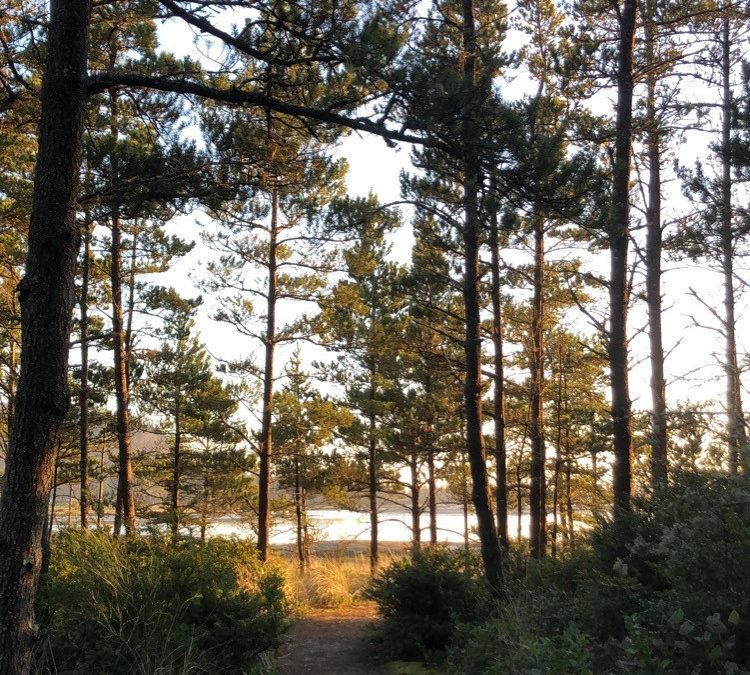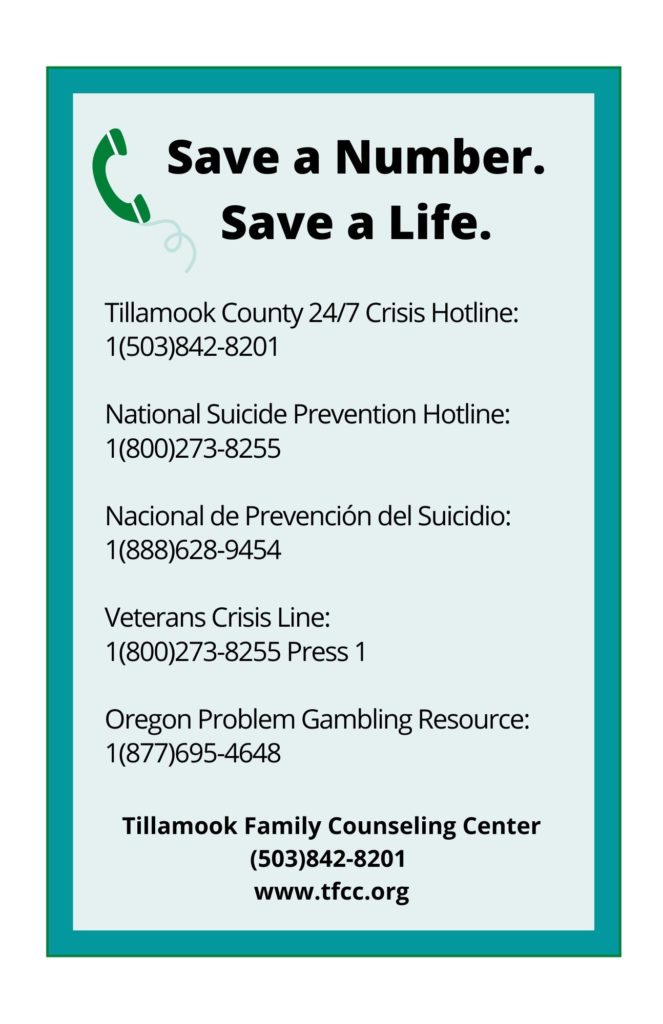
by Guest | Sep 8, 2021 | Being Well
Good things are happening in our local schools. If you have driven along Hwy 101 through South Tillamook County, you probably noticed changes at Cloverdale Elementary School. At a recent Nestucca Valley Chamber meeting, School Superintendent Misty Wharton gave a tour of the elementary school upgrades and the addition that will house the district’s middle school grades 6-8. Along with the much-needed facelift, the school now has clean water, generator capacity and a 10,000 square foot gym that doubles as an emergency shelter. Other features include a new kitchen, media center, computer lab, and career technology lab.
Students will especially benefit from the new covered outdoor play area and playground equipment, sports fields and beautiful school garden ready for harvest. Through innovative partnerships, Nestucca school district is offering hands-on nutrition and science programming, all enhanced by the recent upgrades. The design and atmosphere of the new space is beautiful and welcoming. Kids returning to school will get a true sense of how much their community cares about their learning environment.
People spend a large portion of their lives at school and work. These environments affect our health and sense of well-being. According to Tillamook School Superintendent, Curt Shelley, “Tillamook is a great community to work and live in, where everyone can enjoy a healthy lifestyle. Fall is an exciting time as we welcome staff and students back to school.” Some of the activities Tillamook School District 9 is working on include:
- Finishing up bond projects, including the Liberty bus drop off/pick up and parking lot. This improvement was needed for safety purposes to move loading and unloading off Stillwell Avenue. It will also provide joint parking between the Y and TSD9.
- Remodeling the high school science lab with much needed workstations and additional storage.
- On-going system-wide wellness initiative that includes mentoring, Wellness Wednesdays and other activities that support social and emotional wellbeing. These have been very popular and impactful in improving staff and student experience at TSD9.
Neah-Kah-Nie School District (NKN) is also making investments to help students build health and resilience. Two new 5000 square foot covered play structures were recently built at Garibaldi Grade School and Nehalem Elementary. These structures enable students to recreate during and after school hours outdoors in inclement weather. NKN has also expanded half day preschool at the School District main office to full time preschool at Garibaldi Grade School and Nehalem Elementary.
Through a medical sponsorship from the Rinehart Clinic, NKN School District has added a new school-based health center that will be staffed by a Rinehart Clinic Family Nurse Practitioner on a part-time basis. The district has also hired a full-time school nurse. The time dedicated to nursing services will almost double from last year and will serve pre-K through 12th grade students who reside in the School District boundaries.
School-based wellness centers can provide well checks, sports physicals, care for illness and injury, immunizations, covid testing and vaccinations, routine lab tests, prescription medication support, vision and dental screenings and referrals, and other health education and counseling, including age-appropriate reproductive health information.
Tillamook County schools all offer comprehensive wellness services, including mental health counseling and trauma-informed learning environments. Support for LGBTQ students and on-going efforts to increase equity within school settings is a priority for our local schools. Having a sense of belonging in nurturing environments is very important to a child’s development. When kids feel safe and valued, they can focus on learning and developing into resilient adults later in life.
We have all been through a lot this past year and a half, but disruptions in academic and social routines can be especially difficult for kids. We are excited to share the care and concern local school districts are demonstrating on behalf of students, staff and faculty.
AUTHOR: Michelle Jenck, Tillamook County Wellness Coordinator
For more local health and wellness information, follow Tillamook County Wellness on Facebook, Instagram and Twitter.

by Guest | Sep 1, 2021 | Recipes
Prep time: 15 minutes
Cook time: 20 minutes
Ingredients
For quesadillas:
- 12 soft corn tortillas (6 inches)
- 1 1/2 cups cheddar cheese, shredded
- 1 cup corn kernels (fresh, frozen/thawed, or canned/drained)
- 1/2 cup beans, black or pinto (canned or cooked; drained)
- 1/2 cup cilantro, chopped
- 1 bell pepper, finely chopped
- 1 jalapeno pepper, finely minced (optional)
- 1 carrot, shredded
For Cilantro Yogurt Dip:
- 2 cups plain nonfat yogurt
- 1/4 cup cilantro, finely chopped
- 1/2 teaspoon salt
Directions
- Preheat large skillet over low heat (250 °F in an electric skillet).
- Divide cheese, corn, beans, cilantro, shredded carrots and peppers between the tortillas, covering about half of each tortilla. Fold each tortilla in half over the filling.
- Place one or two folded tortillas on a dry skillet and heat until cheese is melted and tortilla is slightly golden, about 3 minutes.
- Turn over and cook other side until golden, about 1 minute.
- Remove to a plate and repeat until all tortillas are heated.
- Mix together nonfat yogurt, cilantro and salt to make the dip.
- Cut each quesadillas into wedges and serve immediately with the dip.
- Refrigerate leftovers within 2 hours.
Note: One large ear of corn makes about 1 cup of cut corn.
Photo & Recipe Source: https://www.foodhero.org/recipes/veggie-quesadillas-cilantro-yogurt-dip

by Guest | Sep 1, 2021 | Being Well
There are many resources in our community to support people during a crisis. One of the best and most important ways to build community resilience is for more people to get involved. There are many free trainings and volunteer opportunities through which we can build a stronger community response to meet the needs of those around us. Janeane Krongos, Prevention Coordinator with the Tillamook Family Counseling Center, shared this information about the upcoming QPR Gatekeeper training:
One of my roles as a Prevention Coordinator at the Tillamook Family Counseling Center is to provide community members with opportunities to be trained in the Question, Persuade, and Refer (QPR) Gatekeeper training. This training is an evidenced based suicide prevention training that has been used worldwide. Participants who attend this training can expect to learn, common suicide warning signs, suicide facts, how to offer hope, and the three steps of QPR.
This past year, TFCC presented eight free QPR Gatekeeper trainings (trainings were presented September 2020-July 2021). I am happy to report that there were 85 community members who had attended one of these trainings. TFCC will continue to offer these trainings to community members throughout this year. The next two QPR Gatekeeper trainings will take place virtually, September 8th at 10:00-11:30AM and September 24th at 10:00-11:30AM. To learn more about these trainings please feel free to contact me at Janeanek@tfcc.org.
Recently, I contacted former QPR Gatekeeper training participants to request feedback for this training. I was fortunate enough to receive many thoughtful responses from past participants. Continue reading to learn what local participants liked about this training.
“This was my first time taking a response training focused on mental health. I have had difficult conversations in the past with friends about depression or suicide and I have always struggled in knowing the best way to respond or support someone. The QPR course offered an outline for how to approach these conversations, which I greatly appreciated because you never know when you might need to rely on that training.”
– Public Health Professional
“I appreciated the QPR gatekeeper training, because it offers hope by providing concrete ways to respond to friends, family members, or co-workers who might be at risk of suicide.”
– Community Response Coordinator Advocate for Tides of Change
“I liked the fact that it went into detail on how we should go about asking a person questions, to find out if they are considering attempting suicide. I also liked the fact that there were several participants, who were involved in the session & had their own input.”
– Worksource JOBS Program
“What I appreciated about the QPR training was the way it removes both the stigma around suicide and the hopelessness that once a person has decided to take their life there is no turning them around.”
– Faith Leader
“Things that I enjoyed about the QPR gatekeeper training, offered free of charge, required only 1 morning of my time, was a small group with local names and faces, the material is from a trustworthy source and I was confident that it was taught to fidelity standards, Nothing presented was beyond my comfort zone, no follow up was required to prove that I retained what was taught, and mostly, I feel empowered to effectively intervene with family, friends, or clients when I suspect they might be considering suicide.”
– Family and Youth Services Coordinator
“I thought the QPR training was very helpful and useful when we encounter a Veteran that is having a mental health crisis”.
– Veterans Services
“I like that they gave actual data, and I liked that they gave examples of what to do and what not to do.”
– Student
“The QPR was very informative and professional. I learned a lot. I disposed of some myths in my thinking.”
– Retired teacher
“QPR was a safe and positive learning opportunity, as a virtual space to raise my awareness, learn about things to look for, and gain tools to respond. I highly recommend this learning opportunity!”
– Nonprofit Organization Staff/Parent
“I really enjoyed being together with other invested folx to remind us that we can create a network of support in our very own communities. The training also addresses common misconceptions and myths around suicide, urging us to Question, Persuade, and Refer (QPR), in order to save lives. I would definitely recommend this training to others and would be interested in learning how this training is adapted to be shared amongst youth.”
– Community Member/Social Worker
Together, we can build a safer community. To learn more about resources in Tillamook County, visit these sites:
AUTHOR: Janeane Krongos, Prevention Specialist at Tillamook Family Counseling Center
And for more local health and wellness information, follow Tillamook County Wellness on Facebook, Instagram and Twitter.

by Guest | Aug 25, 2021 | Recipes
Prep Time: 10 minutes
Cook Time: 20 minutes
Ingredients
- 1 Tablespoon margarine or butter
- 1 small onion (1/2 cup chopped or sliced)
- ¼ cup chopped, sliced or slivered almonds
- 2 Tablespoons packed brown sugar
- 2 Tablespoons orange juice (juice from 1/4 orange)
- 1 Tablespoon prepared mustard
- 4 cups green beans, fresh cooked, frozen, or canned, drained and rinsed
Directions
- Wash hands with soap and water.
- Melt margarine or butter in a medium skillet over medium heat. Add onion and almonds and cook until onions are tender.
- In a small bowl, mix together brown sugar, orange juice and mustard. Stir into onion mixture.
- Cook 2 to 3 minutes, until sauce begins to thicken. Stir in green beans and cook for 3 to 5 minutes, or until heated through.
- Refrigerate leftovers within 2 hours.
Notes
- 4 cups of green beans is about 1 pound fresh OR 16 ounces frozen OR 2 cans (15 ounces each)
- To cook fresh green beans: Wash and trim green beans. Cut or snap into desired length. Place in a small saucepan and fill with enough water to cover beans. Bring to a boil. Cover and cook until crisp-tender, about 5 to 7 minutes. Drain beans and set aside.
- For extra flavor, add ¼ cup dried cranberries to the skillet along with the green beans.
Photo and Recipe Source: https://www.foodhero.org/recipes/green-beans-onions-and-almonds

by Guest | Aug 25, 2021 | Move Well
Have you ever noticed a sense of calmness and relaxation while spending time outdoors? Felt your stress slip away while hiking or spending time near a body of water? If you have, you may have recognized the benefits of forest therapy without even realizing it. Forest therapy, also known as forest bathing, is the immersion in and embracing of nature with all your senses. This practice, which has begun to grow in popularity, has mental, physical, and spiritual benefits that you can harness from right here in Tillamook County.
If you spend a lot of time outdoors, you may have already noticed some of the mental and spiritual benefits of forest bathing in your own life. Studies have shown that forest therapy can improve mental health, leading to reductions in stress, depression, anxiety, and negative emotions. People who participate in forest therapy sessions, especially in a group, often develop a sense of community among strangers and a deeper connection to the natural world. Additionally, time spent outdoors has been shown to be positively correlated with having more gray matter in your brain and can lead to a better mood.
There are also physical benefits to forest therapy. A study of older adults suggested spending time in nature can help lower blood pressure, especially when compared to spending time in a city. Another study showed that forest therapy may boost immune function by increasing the number of white blood cells (immune cells) and anti-cancer proteins in your blood. Both of these can improve your overall health and lower your risk of diseases like Type 2 diabetes and cancer.
Wondering how you can gain the benefits of forest therapy? Organizations like the Association of Nature & Forest Therapy offer programs for those interested in a guided forest therapy experience. Several of the guides in their registry are located in Oregon and can be contacted by those interested in a forest therapy experience. You can also attend their virtual training to become a Forest Therapy Guide yourself!
You can also get the benefits of forest therapy on your own. For a more self-directed experience, find a hiking trail or other natural area nearby and just enjoy spending time outside. Keep in mind that hiking and spending time in the woods may not impact everyone in the same way. Some people experience these benefits more when they are near water or on a mountain top. What matters is exploring which natural environments help you feel calmer and more connected to yourself and the world around you. You can use the new Tillamook County Trails and Recreation Map at https://tillamookcoast.com/recreation-map/ to find a new spot or return to an old favorite.
While you’re out, consider taking time to connect more deeply with the nature around you. You can do this by engaging senses you don’t use as frequently while outdoors (such as focusing on the feeling of the bark of a tree or closing your eyes and thinking about what you smell around you). Also be sure to take some time for internal reflection both during and after the experience, maybe involving some meditation or deep breathing. You can also share the experience with others and discuss how you felt as a group.
Tillamook County is full of wonderful natural spaces for you to explore. With all the benefits of forest therapy, physical activity, and the last of our warm summer weather, it’s a great time to get out and enjoy them.
AUTHOR: Amy McVeety, AmeriCorps VISTA at Tillamook County Community Health Center
For more local health and wellness information, follow Tillamook County Wellness on Facebook, Instagram and Twitter.






